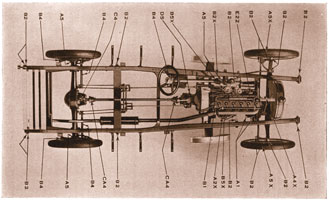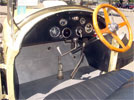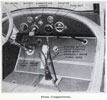
The Initial Freshening
Go to <Last, Summary, Next>Chassis—Convert Back To Left-Hand Drive?
 The chassis of a Kissel Model 6-55 showing the numerous items requiring frequent lubrication |
 |
 |
| CONTROLS: The conversion to right-hand drive has resulted in a compromised and cramped driver's position in Bugsby (right). The layout of controls of the American version (left) shows a less cramped driving position and a different relative position for the accelerator. |
Lynn assumes that Bugsby was explicitly manufactured by Kissel for export to Australia. There does not seem to be very many changes to the car from the American version. The most obvious difference is that the steering wheel and foot controls are located on the right-hand side of the passenger compartment. Lynn wonders if this conversion was done at the factory, at the Australian dealership or after it was received by the customer.
This location for the controls is a considerable compromise. While the brake, clutch and accelerator pedals have been moved to the right, there isn't enough room to place the accelerator to the right of the brake pedal as it appeared in the American version. The "natural" position for the accelerator is outside the passenger compartment since the body is sloping inward toward the center of the car on the right side. They had to put it somewhere so the Kissel (?) engineers stuck the accelerator between the brake and clutch, at the base of the steering column. However, the gear shifter and park brake have not been moved from their American position. The result is that the driver's position is considerably more awkward and cramped in this configuration as compared with the American arrangement. One can see that the driver and controls just fit better on the left-hand side of the passenger compartment.
In fact it strikes Lynn that this arrangement is so awkward that he wonders if it was really a factory conversion. Kissel prided itself on a quality, hand-built automobile and the placement of these controls doesn't seem to Lynn to rise to that standard. Lynn thinks it might be possible that the conversion was done at the facilities of the Kissel agent in Rockhampton after the car had been imported into Australia. With this thought in mind, Lynn is looking for some evidence pointing to when or where Bugsby was converted to right-hand drive. Lynn wonders if the distributor in the car is an example of that evidence.
Update Jan. 22, 2006 -- Lynn has found his evidence and it points to this being a factory conversion. There are two items of incontrovertible evidence that show that this car left the Kissel factory with the steering column on the right side. The first item is that a cross member of the frame does not have holes drilled for mounting of the mechanical brakes on the left side. If the conversion were done after the car left the factory, there would have been mounting holes for the brakes. The second item is the "double arm" front steering component. While most of the steering components look like they could be flipped for use on either right-hand or left-hand steering, it is apparent that the double arm is not interchangeable.
From Lynn's casual survey of the steering hardware, it appears that all the hardware can simply be flipped and mounted on the left-hand side of the car. There would need to be some rerouting of throttle and spark advance controls, but that might be relatively easily accomplished. So it seems possible that it might be feasible to restore Bugsby to left-hand drive. The largest question that's bothering Lynn is a concern that such a conversion might destroy some of the historical value of the vehicle. Lynn rationalizes that if the conversion could be done, it could also be undone if necessary. Lynn plans to ask other owners of vintage cars about this question of compromising the historical integrity of the car.
Contact
 with your comments or questions
with your comments or questionsCopyright © 2018 Lynn Kissel
Last updated: May 24, 2009